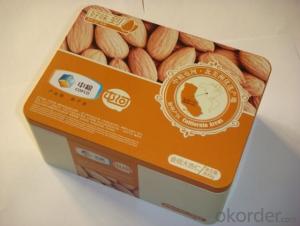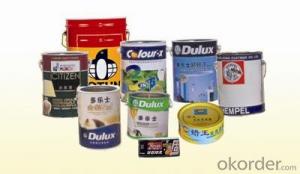MR Tinplate GIS G3303, Stone Finish, Dried Fruit Usage
- Loading Port:
- China main port
- Payment Terms:
- TT OR LC
- Min Order Qty:
- 25 m.t.
- Supply Capability:
- 40000 m.t./month
OKorder Service Pledge
OKorder Financial Service
You Might Also Like
1.Usage
Tinplate is widely used for making all types of containers, containing industrial usage such as paint can, oil can, aerosol cans etc., and food cans like milk powder cans, tomato paste can, dry food cans etc.
2. Quality
As a state owned company and a large tinplate supplier in China, our tinplate quality ranks 1st level in China, similar to Bao Steel, Posco etc.
3. Specification
standard: GB/T2520, JIS G3303, DIN EN10202
Material: MR /SPCC
Thickness available: 0.16-0.50MM
Width available: 600~1050MM
Temper grade: T1 – DR8
Tin coating: ordinary 2.8g/2.8g, 5.6g/5.6g and others
Package: sea worthy export package.
Applications: Tin can for chemicals & paint cans, industrial cans, food cans
4. Our factory photo & equipments

5. Our Markets:
now our tinplate has been sold to more than 50 countries, including Europe country, Gulf Area, South American, South Afric etc.
6. Our Overseas Wareouses:
Furthermore, in the year 2014, we have more than 10 overseas warehouses all over the word, located in KSA, UAE, Oman, Russia, Kuwait, Qatar, Oman, Chile, Brazil etc.
7. FAQ
a. what's the annual output?
about 500,000 tons per year.
b. where's the raw matrial from?
our hot rolled coil is purchased from Capital Steel and other state owned mill, with quite good quality.
c. how long is the delivery time?
normally for SPCC about 45~55 days, while 65~75 days for MR material
d. how to control the quality during production process?
inside our workshop, we have MES syestem. It realizes the optimization of the production procedure in the workshop. It could record each step of the whole production procedures, and if some problem appears, factory could easily found and take action, it’s quite helpful to monitor and control the quality.
- Q:What are the advantages of using tinplate for signage?
- Some advantages of using tinplate for signage include its durability, versatility, and affordability. Tinplate is a strong and sturdy material that can withstand harsh weather conditions, making it suitable for outdoor signage. It can be easily molded into various shapes and sizes, allowing for creative and eye-catching designs. Additionally, tinplate is relatively cost-effective compared to other materials used for signage, making it a practical choice for businesses looking for a cost-efficient solution.
- Q:How does tinplate packaging affect the shelf life of products?
- Tinplate packaging can significantly extend the shelf life of products. Tinplate is a durable and corrosion-resistant material that provides an effective barrier against moisture, oxygen, and light. This protective layer helps to prevent spoilage, maintain product quality, and prolong the freshness of food and other perishable items. Additionally, tinplate packaging offers enhanced protection against external contaminants, such as bacteria, ensuring the safety and integrity of the product throughout its shelf life.
- Q:How does tinplate affect the overall product shelf appeal?
- Tinplate can significantly enhance the overall product shelf appeal due to its attractive and glossy appearance. The metallic finish of tinplate gives products a premium and luxurious look, making them stand out among competitors on store shelves. Additionally, tinplate's durability and ability to maintain its shape and color over time improve the product's presentation, creating a positive impression on consumers.
- Q:What are the typical production volumes for tinplate?
- The typical production volumes for tinplate vary depending on the demand and market conditions, but it is estimated that global production of tinplate amounts to several million metric tons per year.
- Q:How is tinplate coated with organic materials?
- Tinplate is coated with organic materials through a process known as lacquering or varnishing. The organic coating is typically applied to protect the tinplate from corrosion and enhance its aesthetic appeal. The tinplate is first cleaned and treated to ensure proper adhesion of the organic material. Then, the organic coating is usually sprayed or dipped onto the tinplate surface, forming a thin protective layer.
- Q:What are the common sealing options for tinplate containers?
- The common sealing options for tinplate containers include twist-off caps, easy-open ends, peelable lids, and screw-on lids.
- Q:What are the hygiene benefits of tinplate packaging?
- Tinplate packaging offers several hygiene benefits, including providing a protective barrier against external contaminants, preventing cross-contamination, and preserving the quality and freshness of the packaged products. Additionally, tinplate packaging is resistant to corrosion, ensuring the integrity of the packaging and its contents.
- Q:How is tinplate coated for construction materials?
- Tinplate is typically coated for construction materials through a process called electrolytic tin coating. This involves immersing the tinplate into an electrolyte solution and passing an electric current through it. The tinplate acts as the cathode, and tin from the anode is deposited onto its surface, creating a thin layer of tin coating. This coating enhances the corrosion resistance and durability of the tinplate, making it suitable for construction applications.
- Q:What are the common industry standards for tinplate?
- The common industry standards for tinplate include specifications for the tin coating weight, the base metal thickness, surface finish, and the adhesion of the tin coating. These standards ensure consistency and quality in the production of tinplate, allowing for its effective use in various industries such as packaging, automotive, and construction.
- Q:What are the main components of tinplate?
- The main components of tinplate are steel and a thin layer of tin.
1. Manufacturer Overview |
|
|---|---|
| Location | |
| Year Established | |
| Annual Output Value | |
| Main Markets | |
| Company Certifications | |
2. Manufacturer Certificates |
|
|---|---|
| a) Certification Name | |
| Range | |
| Reference | |
| Validity Period | |
3. Manufacturer Capability |
|
|---|---|
| a)Trade Capacity | |
| Nearest Port | |
| Export Percentage | |
| No.of Employees in Trade Department | |
| Language Spoken: | |
| b)Factory Information | |
| Factory Size: | |
| No. of Production Lines | |
| Contract Manufacturing | |
| Product Price Range | |
Send your message to us
MR Tinplate GIS G3303, Stone Finish, Dried Fruit Usage
- Loading Port:
- China main port
- Payment Terms:
- TT OR LC
- Min Order Qty:
- 25 m.t.
- Supply Capability:
- 40000 m.t./month
OKorder Service Pledge
OKorder Financial Service
Similar products
New products
Hot products
Related keywords




























